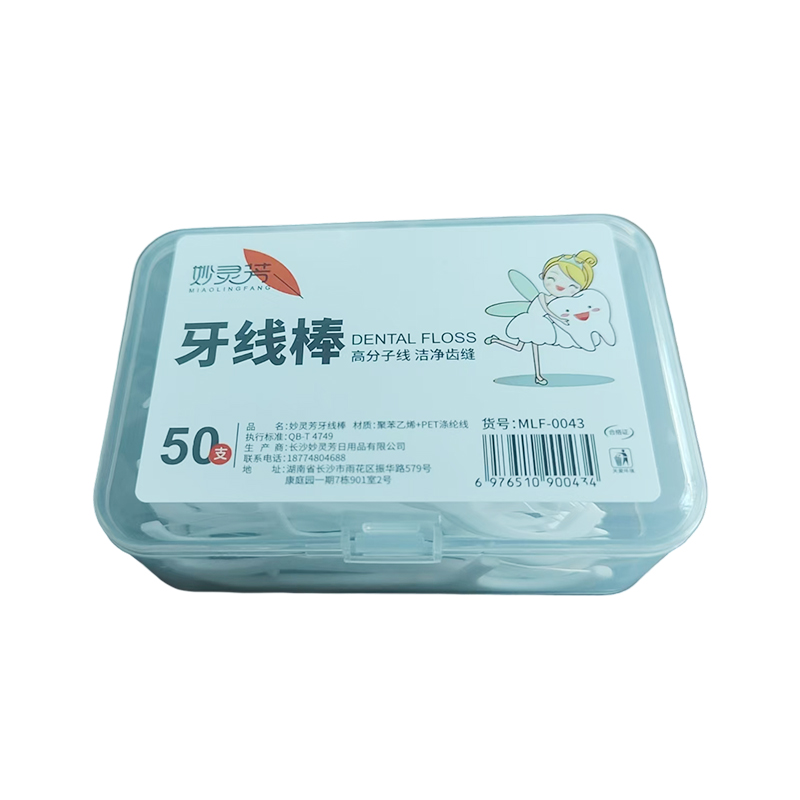How does the material selection of plastic dental floss sticks ensure their safety and non-toxicity for oral use?
Release Time : 2025-09-23
As a daily oral hygiene tool, the direct contact of plastic dental floss sticks with oral tissues makes material safety of paramount importance. The oral environment is sensitive, with thin mucous membranes and abundant blood vessels; any release of harmful substances can be rapidly absorbed, causing local irritation or systemic health risks. Therefore, biocompatibility principles must be strictly followed during material selection, ensuring that the plastic used meets safety standards for human contact in physical, chemical, and biological aspects.
The plastic used to manufacture dental floss sticks must be an engineering material specifically designed for food contact or oral devices, typically polypropylene, polystyrene, or specific copolymers. These materials have stable molecular structures, are not easily decomposed at room temperature, and do not release harmful monomers or additives. Their chemical inertness ensures that no toxic byproducts are generated when in contact with saliva, food residue, and the acidic/alkaline environment of the mouth. Furthermore, the production process must avoid using additives such as phthalates and BPA, which have been proven to have endocrine disrupting effects, eliminating potential toxicity at the source.
Material purity is also crucial. High-quality plastic raw materials should undergo rigorous purification processes to remove impurities, catalyst residues, and unreacted low-molecular-weight compounds. These trace impurities, if remaining in the finished product, may slowly leach out in the warm, moist oral environment, causing chronic irritation or allergic reactions. Therefore, reputable manufacturers typically use pharmaceutical- or food-grade raw materials and conduct batch testing before production to ensure compliance with international safety standards.
During the molding process, control of the injection molding process directly affects the safety of the final product. If molten plastic remains in the mold for too long or at too high a temperature, thermal degradation may occur, producing odors or harmful decomposition products. Therefore, process parameters must be optimized to ensure uniform plasticization and rapid cooling and solidification, avoiding localized overheating. Mold cleaning and maintenance are also crucial to prevent oil, mold release agents, or other contaminants from adhering to the product surface.
The physical properties of the finished product are also closely related to safety. The plastic component of a dental floss stick needs to have the right hardness and elasticity, allowing the floss to slide smoothly between teeth while preventing damage to gums or oral mucosa due to excessive rigidity. The edges must be smooth and free of burrs to avoid scratching the tissues. Any burrs, sharp corners, or surface defects can become irritants, potentially causing micro-trauma and increasing the risk of infection. Therefore, the mold precision and post-processing techniques must be strictly controlled to ensure that every dental floss stick has a smooth and clean surface.
Furthermore, the antibacterial properties of the material are increasingly important. Some high-end products use antibacterial plastic resins or employ safe antibacterial surface treatments to reduce microbial growth during storage and use. Such treatments must ensure that the antibacterial agents do not migrate into the oral cavity and that long-term use does not disrupt the natural oral flora balance.
The choice of packaging material is also crucial. Dental floss sticks are typically sold in individual or bulk packaging; the packaging film must have good barrier properties to prevent dust, bacteria, and moisture from entering. The packaging material itself should also be non-toxic and odorless, preventing any material migration when in contact with the floss stick.
Finally, all material selection and process control must be validated through biocompatibility testing by authoritative organizations, including tests for skin irritation, oral mucosal reaction, and cytotoxicity. Only through such systematic evaluation can it be confirmed that the product is safe for human use.
In summary, the safety of the materials used in plastic dental floss sticks is not determined by a single factor, but rather by ensuring safety throughout the entire process, from raw material selection and processing control to final product testing. Only by maintaining high standards at every stage can this everyday product truly serve oral health, rather than becoming a potential health hazard.
The plastic used to manufacture dental floss sticks must be an engineering material specifically designed for food contact or oral devices, typically polypropylene, polystyrene, or specific copolymers. These materials have stable molecular structures, are not easily decomposed at room temperature, and do not release harmful monomers or additives. Their chemical inertness ensures that no toxic byproducts are generated when in contact with saliva, food residue, and the acidic/alkaline environment of the mouth. Furthermore, the production process must avoid using additives such as phthalates and BPA, which have been proven to have endocrine disrupting effects, eliminating potential toxicity at the source.
Material purity is also crucial. High-quality plastic raw materials should undergo rigorous purification processes to remove impurities, catalyst residues, and unreacted low-molecular-weight compounds. These trace impurities, if remaining in the finished product, may slowly leach out in the warm, moist oral environment, causing chronic irritation or allergic reactions. Therefore, reputable manufacturers typically use pharmaceutical- or food-grade raw materials and conduct batch testing before production to ensure compliance with international safety standards.
During the molding process, control of the injection molding process directly affects the safety of the final product. If molten plastic remains in the mold for too long or at too high a temperature, thermal degradation may occur, producing odors or harmful decomposition products. Therefore, process parameters must be optimized to ensure uniform plasticization and rapid cooling and solidification, avoiding localized overheating. Mold cleaning and maintenance are also crucial to prevent oil, mold release agents, or other contaminants from adhering to the product surface.
The physical properties of the finished product are also closely related to safety. The plastic component of a dental floss stick needs to have the right hardness and elasticity, allowing the floss to slide smoothly between teeth while preventing damage to gums or oral mucosa due to excessive rigidity. The edges must be smooth and free of burrs to avoid scratching the tissues. Any burrs, sharp corners, or surface defects can become irritants, potentially causing micro-trauma and increasing the risk of infection. Therefore, the mold precision and post-processing techniques must be strictly controlled to ensure that every dental floss stick has a smooth and clean surface.
Furthermore, the antibacterial properties of the material are increasingly important. Some high-end products use antibacterial plastic resins or employ safe antibacterial surface treatments to reduce microbial growth during storage and use. Such treatments must ensure that the antibacterial agents do not migrate into the oral cavity and that long-term use does not disrupt the natural oral flora balance.
The choice of packaging material is also crucial. Dental floss sticks are typically sold in individual or bulk packaging; the packaging film must have good barrier properties to prevent dust, bacteria, and moisture from entering. The packaging material itself should also be non-toxic and odorless, preventing any material migration when in contact with the floss stick.
Finally, all material selection and process control must be validated through biocompatibility testing by authoritative organizations, including tests for skin irritation, oral mucosal reaction, and cytotoxicity. Only through such systematic evaluation can it be confirmed that the product is safe for human use.
In summary, the safety of the materials used in plastic dental floss sticks is not determined by a single factor, but rather by ensuring safety throughout the entire process, from raw material selection and processing control to final product testing. Only by maintaining high standards at every stage can this everyday product truly serve oral health, rather than becoming a potential health hazard.







